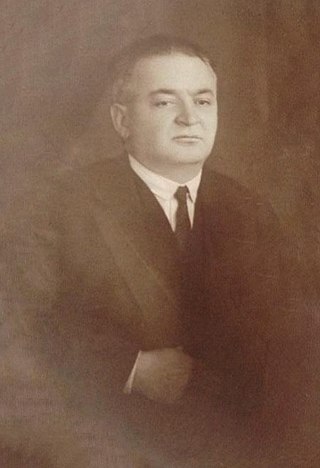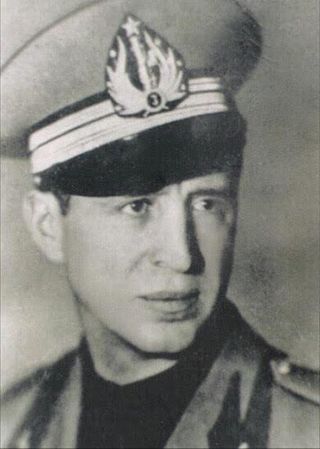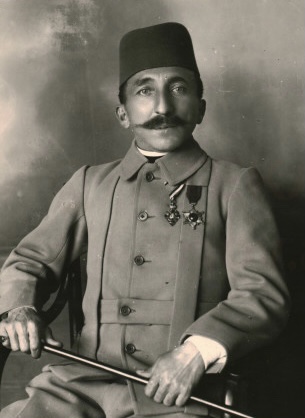Related Research Articles

Zog I was the leader of Albania from 1922 to 1939. At age 27, he first served as Albania's youngest ever prime minister (1922–1924), then as president (1925–1928), and finally as king (1928–1939).

Bajram Curri was an Albanian chieftain, politician and activist who struggled for the independence of Albania, later struggling for Kosovo's incorporation into it following the 1913 Treaty of London. He was posthumously given the title Hero of Albania.

Kachaks is a term used for the Albanian rebels active in the late 19th and early 20th century in northern Albania, Montenegro, Kosovo and Macedonia, and later as a term for the militias of Albanian revolutionary organizations against the Kingdom of Serbia (1910–18) Kingdom of Yugoslavia (1918–24), called the "Kaçak movement".

Azem Bejta, commonly known as Azem Galica, was an Albanian nationalist and rebel who fought for the unification of Kosovo with Albania.

Bedri Pejani was 20th century Albanian politician. During World War II, he was one of the founders of the Second League of Prizren.

Eshref Effendy Frasheri, also referred to as Eshtref Bey Frashëri, was an Albanian politician. He served as co-Chairman of the National Council of Albania from 1921 until 1923 and Deputy Chairman 1932-1938.

Ndok Gjeloshi was an Albanian army officer and Militia commander during World War II.

Shote Galica, born as Qerime Radisheva, was a Kachak Albanian insurgent. She has been declared a People's Heroine of Albania.

The Committee for the National Defence of Kosovo was an Albanian organization founded in Shkodër on 1 May 1918. It was mainly consisted of the political exiles from Kosovo and was led by Hoxha Kadri from Pristina. It existed in looser form since May 1915.
Curri may refer to:

Ceno Kryeziu (1895–1927), also known as Ceno beg (Bey) Jakova, was an Albanian political figure of the 1910s, 1920s. He was a member of the notable Kryeziu family from Gjakova, known to be trusted by Yugoslavian authorities inside Albanian political circles.

Salih bej Vuçitërni was an Albanian political figure and royalist.

Kadri Prishtina (1878–1925), better known as Hoxha Kadri, was an Albanian political figure of the early 1920s.
Qazim Begolli was an Albanian nationalist and activist of the Kachak movement of 20th century.

Hysni Curri (?–1925) was a Kosovar Albanian military figure and a prominent leader of the Kachak movement and the Committee for the National Defence of Kosovo.
The Neutral Zone of Junik (1921–1923) was a neutral demilitarized border area between the Kingdom of Yugoslavia and the Principality of Albania.
"Free Albania" National Committee, also known as "Free Albania" National-Democratic Committee, also National Committee for a Free Albania or NCFA, was a political organization of post-World War II Albanian emigres based in the Western countries. It was supported by the CIA as part of the Albanian Subversion and was a member of the National Committee for a Free Europe. The committee's aim was organizing the Albanian diaspora and cooperating with western powers in overthrowing Enver Hoxha's Communist regime in Albania.
The committee's creation was initiated in Rome and was completed in Paris in the summer of 1949.
Zef Kol Ndoka (1883-1924), also known among Albanians as Zefi I Vogël, was an Albanian warrior and commander from the Shengji family from today's Fan Mirdita in Northern Albania.
The Drenica-Dukagjin Uprisings were a series of Albanian uprisings in the Kosovo regions of Drenica and Dukagjin from 1919 to 1924. The uprisings began after the end of the First World War when Kosovo remained part of the new Kingdom of Yugoslavia. Parts of the Albanian population which resisted Yugoslav rule formed the Kachak movement under the leadership of the Committee for the National Defence of Kosovo and conducted guerilla attacks. A 1919 revolt in Drenica involving 10,000 people was quelled by the Yugoslav army, but uprisings continued in the following years.
References
- 1 2 Hazir Mehmeti (2013-05-07), Hysni Curri, zëri që thërret prehjen në Atdhe [Hysni Curri, the voice that calls to repose in the homeland] (in Albanian), AlbanianPress, archived from the original on 2017-12-01, retrieved 2014-02-09,
Nipi tjetër i Plakut të Maleve ishte Asllan Curri. Sipas gazetë La Feeration Balkanique" e datës 30 prill të vitit 1925, Ahmet Zogu e ka ndër mend të shfaros familjen Curri. Me ndihmën e hijes së tij të zezë Cena Beg Kryeziu, burgoset Asllan Curri dhe vritet bashkë me dy shokë në përcjellje prej Krumës për në Shkodër nga mercenarët e Zogut nën pretekstin "deshi me ik" si kamuflazhe e fshehjes së krimit.
- ↑ Burhan Çiraku; Muin Çami (1982), Bajram Curri, trajtesa e dokumente, Instituti i Historisë (Akademia e Shkencave e RPS të Shqipërisë), p. 12, OCLC 21591761,
Në Normalen e Elba- sanit dërgon 50 të rinj ikosovarë, midis tyre edhe nipin e vet Asllan Currin...
{{citation}}: CS1 maint: multiple names: authors list (link) - ↑ Skënder Drini (1983). Bajram Curri. Shtëpia Botuese "8 Nëntori". p. 354. OCLC 17917369.
Sillte një letër nga Asllan Curri, që ishte krahinar në Krasniqe.
- ↑ Ivo Banac (1988). The National Question in Yugoslavia: Origins, History, Politics. Cornell University Press. p. 305. ISBN 978-0801494932.
Azem Bejta and his main force of a thousand kacaks were betrayed to the Yugoslav gendarmes at the very end of disorders that marked the change in power. Bejta fell on July 15. On December 24, Zogu was back in power at the head of a Belgrade-sponsored regime. He quickly suppressed the Kosovo Committee, had Zija Dibra murdered "while attempting to escape", sent his troops to kill Bajram Curri, and scattered the other Kosovar leaders.